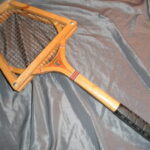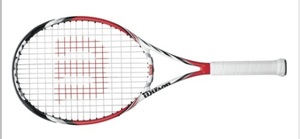In the era of a sports world, where speed, dexterity and technology continue to increase in presence, one thinks back to earlier times and wonders, “Whatever happened to the wooden tennis racket?”
Chances are, many people who played a game of tennis a few decades ago can recall using one. Today, however, net games and long rallies are largely a thing of the past, replaced by speed-record breaking, baseline games in both women’s and men’s matches. Certainly, to most of today’s players, wooden rackets seem quite obsolete or perhaps even inadequate—far too slow, weak, or heavy for professional tennis players who increasingly measure more than six feet tall (even on the women’s side). Even many of today’s recreational players would likely find a wooden racket far to cumbersome to handle as opposed to the lighter, quicker, and stronger metal racket.
So when did the wooden racket give way to the metal racket? To examine this matter, one must go back to the growth of the metal racket, which edged the wooden racket out of a sport in which it played a central role for more than a century.
Enter The Metal Racket
While early models of metal tennis rackets trace back to at least the 1920s, the era of metal tennis rackets in modern tennis began in earnest during the late 1960s. This is when Jimmy Connors was winning matches with the Wilson T2000 steel racket and Pancho Gonzalez won the 1969 Wimbledon with an aluminum racket called the Spalding Smasher.
Such victories proved to the tennis world that the sport was trending toward technological advancements which directly affected the service speed and the type of game being played. Throughout the 1970s, metal tennis rackets grew in favor with professional and amateur tennis players alike.
The 1970s: Metal Versus Wood
Howard Head patented an aluminum racket in 1974. This aluminum racket had a head surface area that was nearly twice the size of other tennis rackets and entered the market as the Prince aluminum racket in 1976. The Prince rackets soon became favored by many professional tennis players, who opted for the speed, strength and lightness of weight of the metal rackets versus the wooden racket, which required comparatively more skill and player dexterity to handle than steel rackets.
Furthermore, the wooden racket was clearly heavier and generally produced slower serves than those produced by metal rackets in the same hands. Though wooden rackets had been rendered by and large nearly obsolete in professional tennis by the end of the 1970s, there were still some players who proved that wooden tennis rackets were still not only competitive—but could still win matches.
1981’s Wimbledon: The Wooden Racket’s Final Hurrah
Undoubtedly, the wooden racket’s swan song came at the Wimbledon tournament of 1981, when John McEnroe used his wooden Dunlop Maxply to beat five-time Wimbledon champion Bjorn Borg in that year’s famous Wimbledon Men’s Single Finals match. During that same tournament, Chris Evert won the women’s final with her wooden Jack Kramer. 1981 was the wooden tennis racket’s last moment of glory as, in fact, it would be the last year a wooden tennis racket would win the Wimbledon finals.
Metal rackets thereafter dominated every corner of professional tennis, with the last wooden racket being played at Wimbledon in 1987. Bjorn Borg, who retired soon after losing to the popular (and entertaining) John McEnroe in the epic 1981 Wimbledon match, made a brief comeback in the early 1990s, making a statement by donning a wooden tennis racket in a 1991 match at the Monte Carlo Open. He quickly lost that event in straight sets against a player ranking fifty-second and wielding a graphite racket.
Though metal tennis rackets have generally been the choice of players both professional and amateur alike for thirty years now, some new wooden tennis rackets can still be found on the market for collectors and those who still prefer the feel and game of a wooden racket.
Resources:
Infoplease. “Tennis, Anyone?” http://www.infoplease.com/spot/00wimbledon1.html
Li, Zehnyu. “Science in Tennis.” People’s Daily Online. 27 December 2006. 24 November 2007.
http://english.peopledaily.com.cn/200612/27/eng20061227_336265.html
Sawai, Akshay. “Material Whirl.” Hindustan Times. 6 July 2007. 25 November 2007. http://www.hindustantimes.com/storypage/storypage.aspx?id=99987639-9c12-4e8a-91e6-355fbc0eb2f4&MatchID1;=4602&TeamID1;=6&TeamID2;=7&MatchType1;=1&SeriesID1;=1157&PrimaryID;=4602&Headline;=Material+whirl
Tenner, Edward. Tennis and the Revenge of Technological Revolution. http://www.primitivism.com/tennis.htm.




